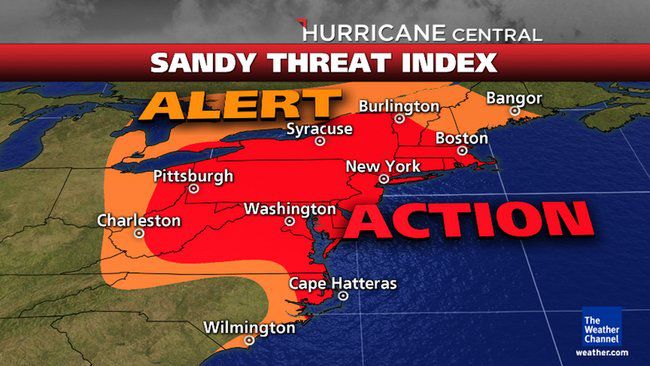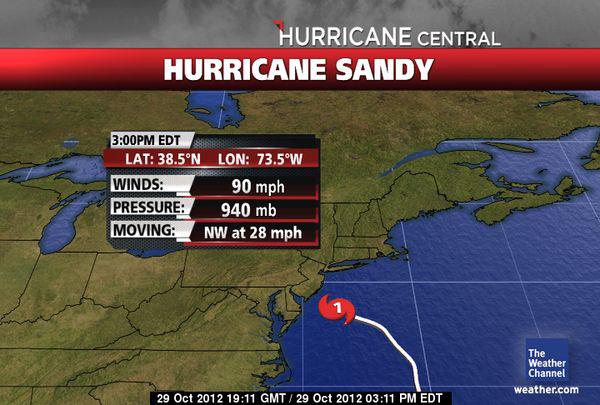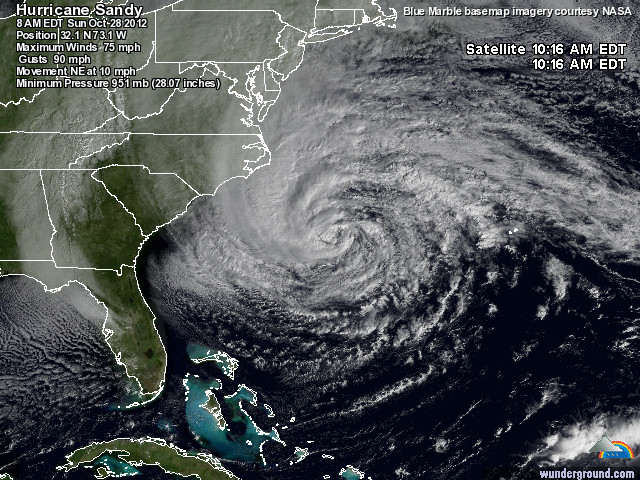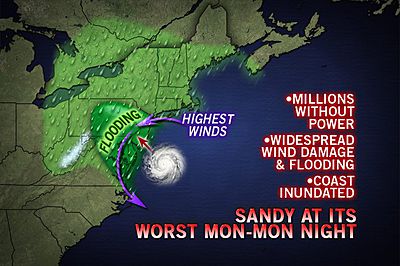
From my memories of Oct.29
2012 9.25 AM :" At the moment
there is a lot of rain, some wind - pretty minimal though, and
lots of water everywhere. We are told to expect higher winds
later tonight and tomorrow morning.
We are very prepared for what's happening. We've got plenty of
food, we made sure we got plenty of water. I am about to go
out soon and fill the car with petrol, in case we might need
to go.
We'll be on a standby, and ready. All Airports , from Newark
to JFK and from Philadelphia to Boston are closed. No Air
Traffic to and from the East Coast. We are waiting the
Storm... the "SuperStorm.."


In the kitchen with my transistor radio tuned on AM 1010 Khz from "1010WINS CBS Radio NYC" listening the Hurricane News..

The 4 Elements Antenna survived at the 90 Mph wind!!!!
Origin of storm
Sandy began as a tropical wave in the Caribbean on Oct. 19. It quickly developed, becoming a tropical depression and then a tropical storm in just six hours. Tropical Storm Sandy was the 18th named storm of the 2012 Atlantic hurricane season. It was upgraded to a hurricane on Oct. 24 when its maximum sustained winds reached 74 mph (119 kph).
Sandy tore through the Caribbean, making landfall at Jamaica on Oct. 24. After leaving that island, the storm gained strength over open water and became a Category 2. The storm hit Cuba early Oct. 25, then weakened to a Category 1. On Oct. 26, it swept across the Bahamas. Sandy briefly weakened to a tropical storm on Oct. 27, then gained strength again to become a Category 1 hurricane before turning north toward the U.S. coast.
Sandy slams Jersey shore
When hurricane hunter aircraft measured its central pressure at 940 millibars � 27.76 inches � Monday afternoon (Oct. 29), it was the lowest barometric reading ever recorded for an Atlantic storm to make landfall north of Cape Hatteras, N.C. The previous record holder was the 1938 "Long Island Express" Hurricane, which dropped as low as 946 millibars.
Sandy's strength and angle of approach combined to produce a record storm surge of water into New York City. The surge level at Battery Park topped 13.88 feet at 9:24 p.m. Monday, surpassing the 10.02 feet record water level set by Hurricane Donna in 1960.
Hurricane Sandy made landfall in the United States about 8 p.m. EDT Oct. 29, striking near Atlantic City, N.J., with winds of 80 mph. A full moon made high tides 20 percent higher than normal and amplified Sandy's storm surge. Streets were flooded, trees and power lines knocked down and the city's famed boardwalk was ripped apart. Along the Jersey shore, people were left stranded in their homes and waited for rescue teams in boats to rescue them. More than 80 homes were destroyed in one fire in Queens. Several other fires were started throughout the New York metro area.
Seawater surged over Lower Manhattan's seawalls and highways and into low-lying streets. The water inundated tunnels, subway stations and the electrical system that powers Wall Street and sent hospital patients and tourists scrambling for safety. Skyscrapers swayed and creaked in winds that partially toppled a crane 74 stories above Midtown. A large tanker ship ran aground on the city's Staten Island.
As of Nov. 1, about 4.7 million people in 15 states were without electricity, down from nearly 8.5 million a day earlier. Subway tunnels in Lower Manhattan remained flooded, but some lines had resumed service. Airlines, which had canceled more than 15,000 flights around the world, were returning to normal schedules. Most gas stations in New York City and New Jersey were closed because of power shortages and depleted fuel supplies. Long lines formed at gas stations that were expected to open.
Sandy will end up causing about $20 billion in property damage and $10 billion to $30 billion more in lost business, making it one of the costliest natural disasters on record in the United States, according to IHS Global Insight, a forecasting firm. The New York City mayor's office in late November estimated total losses to the city to be $19 billion and asked the federal government for $9.8 billion in aid for costs not covered by insurance or FEMA.
By Nov. 1, Sandy had dissipated. The National Weather Service reported that "multiple remnants" were circulating across the lower Great Lakes region and moving into Canada. Some areas were getting residual rain and snow showers. Tides were back down to less than a foot above normal.

;

 Hurricane
Sandy from ISS International Space Station!
Hurricane
Sandy from ISS International Space Station! 
;
;
;
;
